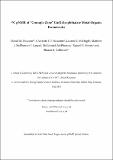Files in this item
13C pNMR of “crumple zone” Cu(II) isophthalate metal-organic frameworks
Item metadata
| dc.contributor.author | Dawson, Daniel M. | |
| dc.contributor.author | Sansome, Charlotte E. F. | |
| dc.contributor.author | McHugh, Lauren N. | |
| dc.contributor.author | McPherson, Matthew J. | |
| dc.contributor.author | McCormick McPherson, Laura J. | |
| dc.contributor.author | Morris, Russell E. | |
| dc.contributor.author | Ashbrook, Sharon E. | |
| dc.date.accessioned | 2020-11-14T00:38:44Z | |
| dc.date.available | 2020-11-14T00:38:44Z | |
| dc.date.issued | 2019-05-14 | |
| dc.identifier | 258577539 | |
| dc.identifier | d9b91cc8-0f96-4946-8d09-9448f1c266ef | |
| dc.identifier | 85065703287 | |
| dc.identifier | 000472018500006 | |
| dc.identifier.citation | Dawson , D M , Sansome , C E F , McHugh , L N , McPherson , M J , McCormick McPherson , L J , Morris , R E & Ashbrook , S E 2019 , ' 13 C pNMR of “crumple zone” Cu(II) isophthalate metal-organic frameworks ' , Solid State Nuclear Magnetic Resonance , vol. In press . https://doi.org/10.1016/j.ssnmr.2019.05.005 | en |
| dc.identifier.issn | 0926-2040 | |
| dc.identifier.other | ORCID: /0000-0002-4538-6782/work/57568185 | |
| dc.identifier.other | ORCID: /0000-0002-8110-4535/work/59464840 | |
| dc.identifier.other | ORCID: /0000-0001-7809-0315/work/61622129 | |
| dc.identifier.uri | https://hdl.handle.net/10023/20978 | |
| dc.description | SEA thanks the Royal Society and Wolfson Foundation for a merit award. REM and LNM thank the EPSRC for support (EP/N50936X/1). | en |
| dc.description.abstract | NMR spectroscopy of paramagnetic materials (pNMR) has the potential to provide great structural insight, but many challenges remain in interpreting the spectra in detail. This work presents a study of a series of structurally analogous metal-organic frameworks (MOFs) based on 5-substituted isophthalate linkers and Cu(II) paddlewheel dimers, of interest owing to their “crumple zone” structural rearrangement on dehydration/rehydration. 13C MAS NMR spectra of the MOFs reveal a wide variation in the observed resonance position for chemically similar C species in the different MOFs but, despite this, resonances are overlapped in several cases. However, by considering a combination of the integration of quantitative spectra, the resonance position as a function of temperature and T1 relaxation measurements, the spectra can be fully assigned. It is also demonstrated that the prototypical MOF in this series, STAM-1, displays a similar crumple zone rearrangement on dehydration to the well-characterised 5-ethoxyisophthalate MOF (STAM-17-OEt) although, while the materials have similar local C environments, dehydrated STAM-1 exhibits less long-range order. | |
| dc.format.extent | 865421 | |
| dc.format.extent | 338155 | |
| dc.language.iso | eng | |
| dc.relation.ispartof | Solid State Nuclear Magnetic Resonance | en |
| dc.subject | Paramagnetic NMR | en |
| dc.subject | Metal-organic frameworks | en |
| dc.subject | 13C | en |
| dc.subject | Fast magic angle spinning | en |
| dc.subject | Cu(II) | en |
| dc.subject | Paddlewheel dimer | en |
| dc.subject | QD Chemistry | en |
| dc.subject | DAS | en |
| dc.subject.lcc | QD | en |
| dc.title | 13C pNMR of “crumple zone” Cu(II) isophthalate metal-organic frameworks | en |
| dc.type | Journal article | en |
| dc.contributor.sponsor | The Royal Society | en |
| dc.contributor.institution | University of St Andrews. EaSTCHEM | en |
| dc.contributor.institution | University of St Andrews. School of Chemistry | en |
| dc.identifier.doi | https://doi.org/10.1016/j.ssnmr.2019.05.005 | |
| dc.description.status | Peer reviewed | en |
| dc.date.embargoedUntil | 2020-11-14 | |
| dc.identifier.grantnumber | WM150021 | en |
This item appears in the following Collection(s)
Items in the St Andrews Research Repository are protected by copyright, with all rights reserved, unless otherwise indicated.


